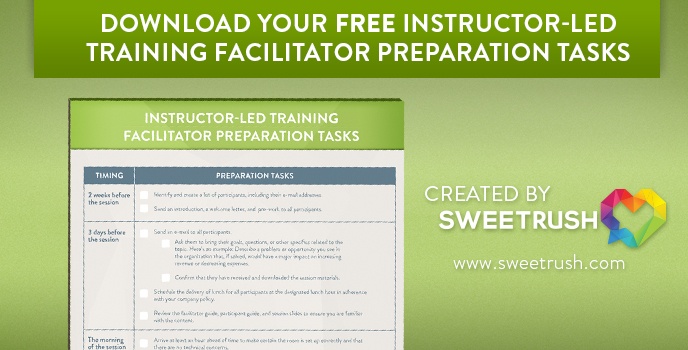Instructor-Led Training Crime Wave Sweeps the Nation: Have You Seen The Facilitator?
Several deaths have been recently reported. The means? Death by PowerPoint®. The innocent victims were the participants of a live instructor-led training event. The assailant, widely known as The Facilitator, took out the entire audience with numerous slides of bullets, leaving the victims unresponsive when found at the scene. Those who survived this grave event seem to be suffering from group amnesia and cannot recall what occurred as The Facilitator delivered bullet after bullet.
Are you guilty of being The Facilitator at your instructor-led training events? If so, you’ve probably fallen into some very common pitfalls that I see frequently in instructor-led training, especially if you are extraordinarily familiar with the content.
Let’s take a look at three pitfalls to avoid when designing and delivering instructor-led training.
Pitfall #1: Your training event design is not engaging and interactive.
My opening to this article was a bit tongue in cheek, but no one can deny that a long session with the facilitator only presenting information is not interesting for participants and inhibits retention.
Here are some tips to make your training event more engaging:
- Add various multimedia elements to your slide deck or presentation, instead of leveraging a standard slide deck with a lot of bulleted points.
- Remember the feeling of excitement and anticipation you got when your grade school teacher turned off the lights to show a video in class? Not only can video and audio clips, infographics, and animations grab learners’ attention, but they can also present information in a new way that makes it easier to understand complicated concepts.
- Everyone is tethered to their smartphones these days. Might as well use it to your advantage! Check out my article on 5 Easy Tips to Use Mobile Learning in Classroom Training for ideas on how to turn up the heat on participant engagement leveraging mobile technology.
- Create a collaborative environment.
- In the beginning of the event, encourage participants to raise their hands if they have questions or think the group needs a break.
- Include of a variety of hands-on activities within your design. Depending on the activity, facilitators have options for breaking a large group into smaller teams to work on exercises, brainstorm, compete during a game, etc. It helps to have people get up and move to a new location to form smaller groups. This physical movement helps with the stupor effect often seen when one sits still for too long.
- Call on participants to provide answers or contribute. Open-ended questions help participants synthesize and apply the concepts being presented.
- Use social media in instructor-led training.
- Create a community space for your training event. Pre-class activities, such as reading, questionnaires, and expectation-setting, can be accomplished effectively via social media. Wouldn’t it be fantastic for you and your learners to post introductions in the community space so you can learn more about each other in advance? Beyond standard introductions, you can also ask about what they’re hoping to learn, and perhaps tailor your content a bit to meet their needs.
- Including post-training exercises keeps the synergy of your live training event alive. Continue to use the community space for learners to discuss their experiences. Participants can share more in-depth articles and links to other resources for ongoing learning and networking.
- For more information, check out my article 7 Tips for Using Social Media in Classroom Learning.
- Build in a break every 45 to 60 minutes.
- Encourage participants to get up and walk around.
- If feasible, have an area for coffee, tea, water, and maybe some light, healthy snacks as an incentive for participants to move.
- Often participants will discuss the session’s content informally, further promoting learning.
Pitfall #2: You are not managing the training event effectively.
Just as typos can undermine the integrity of a document, participants will form negative impressions of a disorganized or flustered facilitator. The best way to feel calm and in control while facilitating your instructor-led training is to be prepared and get your classroom ready to learn. These tips will help you manage your training event like a pro.
- In the beginning of the event, have participants turn off or silence their phones.
- Ensure you are familiar enough with the content so you can tailor it to reflect the participants’ needs and questions.
- Move about the room and continuously scan for disengaged participants. Improvise and tailor the order of events to keep participants engaged. For example, if you are in the middle of a lengthy discussion and see people getting distracted, you could cut it short, have folks move into small groups, and then wrap up your discussion before the next activity.
- Most important, connect with the audience. Be approachable and have a sense of humor. Your role is to facilitate discussion and encourage learning. Again, the “sage on the stage” model of yesteryear does not cut it with today’s learners (of any generation).
Pitfall #3: You are not prepared to facilitate.
- It can be a bit overwhelming to focus on delivering the content, especially if it is only a small part of your job. Here are some things to consider:
- Being “on” for several hours and engaging with participants can take a lot out of you. This may go without saying, but it’s ideal to start the day after a good night’s rest and having eaten breakfast.
- Be ready. Download my free Instructor-Led Training Facilitator Preparation Tasks checklist available below! It will help you stay organized before, during, and after your event.
- Add a moderator to assist you during the event. Particularly for larger groups or training in which participants will use technology (e.g., when teaching computer software), a moderator can help ensure the session goes smoothly by being the timekeeper or dealing with any technical or other challenges on the side.
Have an instructor-led training activity, tip, or experience you want to share? Post a comment below!



